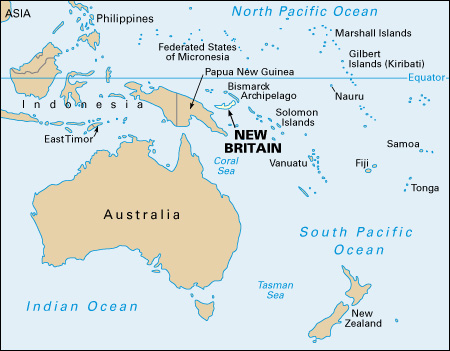Bismarck Archipelago, << BIHZ mahrk `ahr` kuh PEHL uh goh, >> is a group of islands in the southwest Pacific Ocean. The islands lie northeast of New Guinea and are part of the nation of Papua New Guinea. The Bismarck Archipelago consists of more than 200 islands and has a land area of about 18,780 square miles (48,640 square kilometers). The two largest islands are New Britain, which covers 14,093 square miles (36,500 square kilometers); and New Ireland, with an area of 3,340 square miles (8,651 square kilometers). Other main islands include Manus and New Hanover. Manus is the largest of the Admiralty Islands, which are part of the archipelago. Most of the other islands in the Bismarck Archipelago are much smaller.

New Britain, New Ireland, and Manus have rugged mountain ranges and dense forests. New Britain features volcanoes. Many of the small islands are flat. Some are atolls (ring-shaped coral reefs). Located near the equator, the Bismarck Archipelago has a hot, humid climate. At sea level, average temperatures range from 75 to 88 °F (24 to 31 °C).
The Bismarck Archipelago has a population of about 1,250,000. About 65 percent of the people live on New Britain, and about 20 percent on New Ireland. Most of the people are Melanesians. The population also includes several hundred Chinese and Europeans. Most of the people live in small rural villages near the sea. Rabaul—on New Britain—is the largest urban community. It has about 5,000 people. The Melanesians speak many local languages. To communicate with members of different language groups, they use a widely understood language called pidgin English (see Pidgin English).
Most of the islanders fish, farm, and raise chickens and pigs for a living. They grow such crops as coconuts, sweet potatoes, taro, and yams for their own use. Islanders also produce copra (dried coconut meat), coconut oil, palm oil, cocoa, coffee, and timber for export.
In 1528, the Spanish explorer Álvaro de Saavedra became the first European to see parts of the Bismarck Archipelago. Germany claimed the islands in 1884 and named them after the German chancellor Otto von Bismarck. Australian troops captured the islands in 1914, during World War I (1914-1918). Japanese forces occupied the islands from 1942 to 1945, during World War II (1939-1945). After the war, Australia regained control. In 1975, the islands became part of the newly independent nation of Papua New Guinea.
